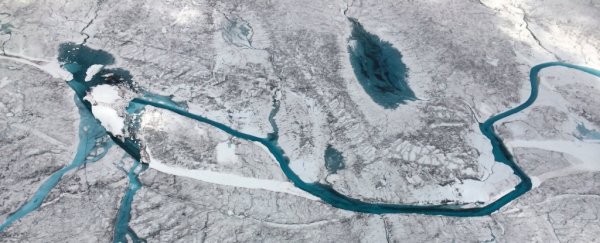Subglacial lakes are some of the least explored and most important natural features on Earth. We have also vastly underestimated their prevalence and impact.
More than 400 of these lakes have now been found beneath the Antarctic continent. Yet as recently as the 1950s, scientists thought this ice sheet contained no liquid water whatsoever.
Today, a similar story is unfolding in the Northern Hemisphere. New research has increased the number of known lakes lurking beneath the Greenland ice sheet by 14-fold, going from just four recognised bodies of water to a total of 60.
"This study has for the first time allowed us to start to build up a picture of where lakes form under the Greenland Ice Sheet," says lead author and hydrologist Jade Bowling from Lancaster University.
"This is important for determining their influence on the wider subglacial hydrological system and ice-flow dynamics, and improving our understanding of the ice sheet's basal thermal state."
Greenland's ice sheet is multiple kilometres thick (roughly 1.9 miles) and it's still unclear what exactly goes on underneath its frozen exterior. As the world continues to warm, the frozen colossus has been losing an estimated 244 billion tonnes of ice each year, and if the entire thing is left to melt, it could raise sea levels by up to 7 metres (23 feet).
Understanding what glacier meltwater does on its way from the surface to the bed is therefore crucial for future climate models, and subglacial lakes are an important transitory stop.
When these bodies of water fill and drain in Antarctica, they can cause overlying ice to flow faster, and scientists think the same thing could be happening in Greenland. A study published last year, in fact, predicted that the chain reaction of water drainage in Greenland could speed up ice flow by as much as 400 percent.
But while mathematical models have predicted that the Greenland ice sheet is home to thousands of these subglacial lakes, actually finding them is another story.
The first complete inventory of subglacial lakes has only turned up 56, and the painstaking analysis required manually sifting through 500,000 km-worth of airborne radio echo data, as well as ice-surface elevation changes which show how these lakes swell and deflate over time.
Unlike Antarctica's lakes, which can reach up to 11 kilometres in length, the subglacial lakes that have been found in Greenland are much smaller, ranging from just 200 metres in length to nearly 6 kilometres. They are also generally stable and buried beneath relatively slow moving ice, clustering around the margin of the ice sheet.
 (Andrew Sole, University of Sheffield)
(Andrew Sole, University of Sheffield)
"In the centre of the [Greenland ice sheet], ice is largely frozen to its bed, with water becoming more prevalent towards the margin where ice surface speeds are typically higher and surface-to-bed hydraulic connectivity more likely," write the authors.
Slightly less than half of these newly identified lakes are active, meaning they both drain and fill from ice-surface elevation changes. But while rare now, the authors of the report are worried that these structures could become more common in the future.
As the climate continues to warm, the surface meltwater in Greenland may well start to form lakes and streams higher up in the ice sheet, as is happening with Antarctica. When these bodies of water drain down to the bottom, scientists think they could 'reactivate' these subglacial lakes, reducing the overall stability of the ice sheet.
"The resulting increased input of meltwater to the bed at higher elevations could open new subglacial drainage pathways through enhanced sliding and potentially connect this dormant storage to the ice sheet margin," the authors explain
On the edges of Greenland's icy structure, where melting tends to occur faster, the authors noticed some evidence that this is already occurring in two activated lakes.
"These 'active' lakes that fill and drain, making the ice lift up and down, seem to be rare," co-author Stephen Livingstone from the University of Sheffield told the BBC.
"But we speculate that the signal of active subglacial lakes near the margin of the ice sheet may actually be being lost because this is where a lot of surface meltwater gets down to the bed."
In other words, the margins of Greenland's ice sheet might be hiding even more of these dynamic subglacial lakes. As our world rapidly warms, knowing where and how they exist could make all the difference.
The research was published in Nature Communications.
